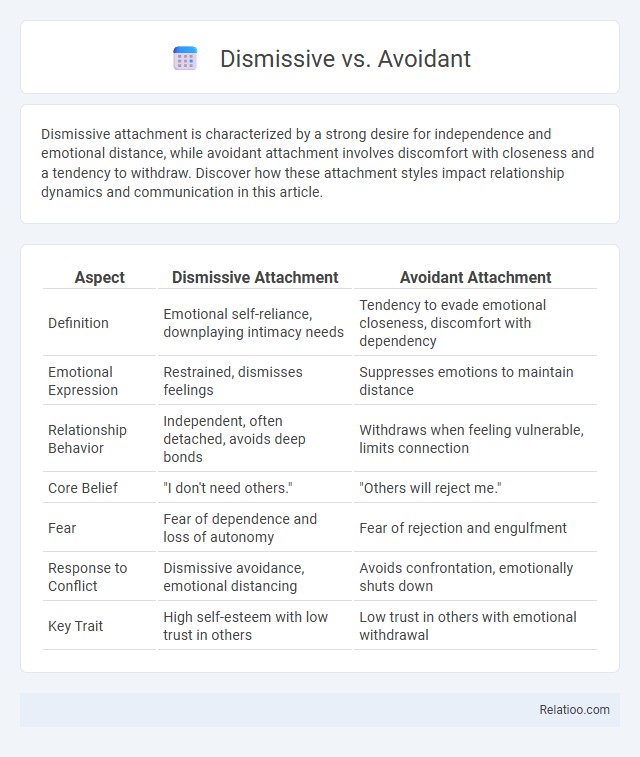Dismissive attachment is characterized by a strong desire for independence and emotional distance, while avoidant attachment involves discomfort with closeness and a tendency to withdraw. Discover how these attachment styles impact relationship dynamics and communication in this article.
Table of Comparison
| Aspect | Dismissive Attachment | Avoidant Attachment |
|---|---|---|
| Definition | Emotional self-reliance, downplaying intimacy needs | Tendency to evade emotional closeness, discomfort with dependency |
| Emotional Expression | Restrained, dismisses feelings | Suppresses emotions to maintain distance |
| Relationship Behavior | Independent, often detached, avoids deep bonds | Withdraws when feeling vulnerable, limits connection |
| Core Belief | "I don't need others." | "Others will reject me." |
| Fear | Fear of dependence and loss of autonomy | Fear of rejection and engulfment |
| Response to Conflict | Dismissive avoidance, emotional distancing | Avoids confrontation, emotionally shuts down |
| Key Trait | High self-esteem with low trust in others | Low trust in others with emotional withdrawal |
Understanding Attachment Styles
Understanding attachment styles is crucial for recognizing patterns in your relationships and emotional responses. Dismissive attachment is characterized by a strong desire for independence and emotional distance, while avoidant attachment involves discomfort with closeness and a tendency to evade intimacy. Differentiating between these styles helps you identify underlying behaviors and improve communication and connection with others.
Defining Dismissive Attachment
Dismissive attachment is characterized by a strong desire for independence and emotional distance, often leading individuals to suppress feelings and avoid intimacy. Avoidant attachment involves discomfort with closeness but may not strongly reject relationships, instead showing reluctance to fully engage emotionally. While dismissive attachment emphasizes self-reliance and minimizing emotional needs, avoidant attachment reflects a broader pattern of ambivalence toward connection and vulnerability.
Characteristics of Avoidant Attachment
Avoidant attachment is characterized by a strong desire for independence and a tendency to distance oneself emotionally from others, often to protect against vulnerability. You may find it difficult to trust others or share your feelings, preferring self-reliance over intimacy. This attachment style often leads to discomfort with closeness and a preference for maintaining personal space in relationships.
Key Differences: Dismissive vs Avoidant
Dismissive and avoidant attachment styles both involve emotional distance, but dismissive attachment is characterized by a strong sense of independence and a downplaying of the importance of close relationships, whereas avoidant attachment stems from fear of intimacy and discomfort with emotional closeness. Your interactions with someone who is dismissive may feel detached and self-reliant, while avoidant individuals often withdraw due to anxiety about vulnerability. Understanding these key differences helps in navigating relationship dynamics and improving communication strategies.
Childhood Origins of Both Styles
Dismissive and avoidant attachment styles both stem from childhood experiences of emotional neglect or inconsistent caregiving, impacting Your ability to trust and form close relationships. Dismissive attachment often arises when caregivers are emotionally unavailable or dismissive of a child's needs, leading to self-reliance and emotional detachment. Avoidant attachment develops from caregivers who are unresponsive or rejecting, causing children to suppress emotions and avoid intimacy to protect themselves.
How Attachment Shapes Adult Relationships
Dismissive and avoidant attachment styles both stem from early emotional neglect, causing adults to minimize intimacy and suppress feelings to protect themselves from vulnerability. Your ability to form close, trusting relationships is shaped by these patterns, where dismissive individuals often appear emotionally distant while avoidant individuals avoid closeness altogether. Understanding these differences helps you recognize how attachment influences your emotional needs and interpersonal dynamics in adult relationships.
Common Behaviors in Dismissive Individuals
Dismissive individuals often exhibit a strong preference for independence, avoiding emotional closeness and minimizing the importance of relationships to protect themselves from vulnerability. You may notice behaviors such as suppressing feelings, downplaying others' emotional needs, and maintaining emotional distance during conflicts or intimate conversations. These common traits differentiate dismissive attachment from avoidant patterns, highlighting a unique defense mechanism rooted in self-reliance and emotional detachment.
Recognizing Avoidant Reactions
Avoidant reactions commonly manifest through emotional withdrawal, reluctance to engage in deep conversations, and a tendency to minimize the importance of relationships. Recognizing these behaviors is crucial for distinguishing avoidant attachment from dismissive traits, which often include overt defensiveness and a strong need to assert independence. Understanding avoidant responses enables more effective communication and fosters healthier relational dynamics by addressing underlying fears of intimacy and vulnerability.
Navigating Relationships With These Attachments
Understanding dismissive and avoidant attachment styles is crucial for navigating relationships effectively, as both involve emotional distance but differ in their underlying motivations and behaviors. Dismissive individuals often suppress feelings to maintain independence, while avoidant partners may withdraw to protect against perceived threats to intimacy. Recognizing these patterns allows you to foster healthier communication and build trust, ensuring your relationships thrive despite attachment challenges.
Healing and Growth Strategies
Healing from dismissive and avoidant attachment styles involves developing self-awareness and emotional regulation through therapeutic practices like cognitive-behavioral therapy (CBT) and mindfulness. Growth strategies emphasize building trust in relationships by practicing vulnerability, improving communication skills, and challenging negative beliefs about intimacy. Consistent support from trusted individuals and professional counseling can accelerate progress toward secure attachment and emotional resilience.

Infographic: Dismissive vs Avoidant
 relatioo.com
relatioo.com